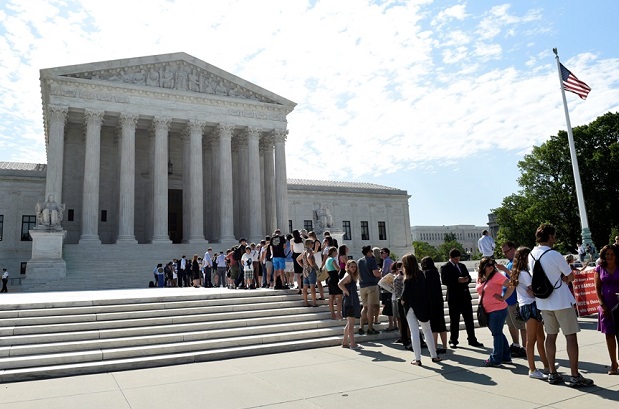 That the Trump administration's Solicitor General has come down clearly on the side of participants speaks to the strength of their case, said Cohen Milstein partner Michelle Yau, a lead attorney for the plaintiffs. (Photo: AP)
That the Trump administration's Solicitor General has come down clearly on the side of participants speaks to the strength of their case, said Cohen Milstein partner Michelle Yau, a lead attorney for the plaintiffs. (Photo: AP)
Does the Employee Retirement Income Security Act allow participants in a defined benefit pension plan to sue sponsors for mismanagement of assets even when a plan is fully funded?
The Trump administration's Solicitor General, Noel Francisco, and the Labor Department's top lawyers say the answer is unambiguous: ERISA absolutely does.
Earlier this year, the Supreme Court invited the Solicitor General to file a brief in Thole v. U.S. Bank, a class action brought by U.S. Bank retirees in 2013 that alleged the plan's trustees violated ERISA by mismanaging plan assets. The Supreme Court agreed to hear the case during its upcoming fall session.
Between September of 2007 and the end of 2010, the plan was solely invested in equities, including individual stock holdings and mutual funds managed by a U.S. Bank subsidiary.
At the outset of that period, the plan was over-funded by more than $850 million. But by 2008, as the financial crisis took hold, the plaintiffs allege the plan lost more than $1.1 billion, dramatically reducing the plan's funded status to 84 percent.
The plaintiffs alleged that equities-only strategy was unduly risky and caused the plan unnecessary losses, and was a violation of by ERISA's prohibited transaction provisions and its prudence provisions, which specifically include adequate diversification of assets as a necessary practice.
Timely, big contributions to plan by U.S. Bank
In April of 2014, the U.S. District Court for the District of Minnesota partially granted U.S. Bank's motion to dismiss the claim. The mismanagement of assets claim was time-barred under ERISA's statute of limitations, the court found.
The court did say the plaintiffs had standing to bring the case, and that claims that U.S. Bank violated ERISA's prohibited transaction by investing through a subsidiary could move forward.
In May of 2015, as the case was grinding through the discovery phase, the Supreme Court issued its ruling in the landmark Tibble v. Edison case, finding that ERISA's statute of limitations did not excuse plan fiduciaries' duties to monitor plan investments.
Plaintiffs' attorneys informed U.S. Banks's attorneys they would be amending their complaint.
And U.S. Bank attorneys informed plaintiffs' attorneys that the bank had made a $311 million contribution to the plan, well in excess of its required annual contribution, making the plan over-funded.
U.S. Bank filed a second motion to dismiss the case, and in December of 2015, the District Court did just that, on the grounds that the plaintiffs' claims were moot—the plan was now fully funded, and as such, the plaintiffs were owed no further monetary relief.
The plaintiffs appealed that decision, and in October of 2018, the Court of Appeals for the Eighth Circuit upheld the lower court ruling.
"Given that the plan is overfunded, there is no 'actual or imminent injury to the Plan itself' that caused injury to the plaintiffs' interests in the Plan," the 8th Circuit said, basing its conclusion on a 2002 ruling in Harley v. Minnesota Mining & Manufacturing Co.
"The plaintiffs must show actual injury—to the plaintiffs' interest in the Plan and to the Plan itself—to fall within the class of plaintiffs whom Congress authorized to sue under the statute (ERISA)," the 8th Circuit added.
Solicitor General
In recommending the Supreme Court review the case, the Solicitor General said the question of whether or not participants in an over-funded defined benefit plan have standing to sue under ERISA has "generated tension, if not an outright conflict," among courts of appeals, and said most lower courts have decided the issue "incorrectly."
The plaintiffs in the U.S. Bank case are "squarely within the class of plaintiffs Congress has authorized to sue under ERISA," the Solicitor General's brief said. "Nothing in the text of ERISA conditions a fiduciary's duties to beneficiaries on whether the plan is a defined-benefit or defined-contribution plan, or whether the plan is overfunded or underfunded."
That the Trump administration's Solicitor General has come down so clearly on the side of participants in a class action speaks to the strength of their case, said Michelle Yau, a partner at Cohen Milstein and a lead attorney for the plaintiffs in the case.
"It's a big deal," said Yau of a Republican administration siding with plaintiffs in a class-action claim, "but not surprising, given how clear ERISA is that standing is not tied to a plan's funded status."
The Solicitor General's brief supports the Labor Department's longstanding position on the question of ERISA's fiduciary requirements, irrespective of a plan's funded status, said Yau.
"They completely got it right and that underscores the strength of our case," she told BenefitsPRO. "This is a black and white question—ERISA says nothing about funded status and prudence."
Yau concurred, unsurprisingly, with the Solicitor General in that lower courts have issued misguided rulings on the question of funded status, standing, and injury to pensioners.
"Lower courts have been essentially saying that until your pension check comes in short, you don't have standing. But ERISA certainly doesn't say that. Court after court has been getting this wrong—so wrong, that our belief all along has been this will get reversed. It's just a matter of time," said Yau.
The conservative justices on the High Court, whom Yau called "some of the brightest minds in our country," are bound to agree with the Solicitor General's brief. "I have a hard time imagining them disagreeing with it," she said.
A date has not been set, but the Supreme Court will hear arguments in Thole v. U.S. Bank during the fall session.
A victory for the plaintiffs is likely to remand the case back to the 8th Circuit Court of the Appeals, which would likely remand the claim back to the District Court for the case to be reheard.
That would mean U.S. Bank would have to re-defend exactly why it chose such an unusual asset allocation strategy back in 2007.
ERISA's Prudent Man Standard of Care is met, in part, by "diversifying the investments of the plan so as to minimize the risk of large losses, unless under the circumstances it is clearly prudent not to do so," according to language in the statute.
During the first go-round in District Court, Judge Joan Ericksen inquired of attorneys whether there was case law supporting a "black letter rule" as to when a 100 percent equity strategy would be prudent.
She ultimately answered her own question.
The reason no such cases exist is because "no one is ever dumb enough to do it," said Judge Ericksen, according to court transcripts.
READ MORE:
© Touchpoint Markets, All Rights Reserved. Request academic re-use from www.copyright.com. All other uses, submit a request to [email protected]. For more inforrmation visit Asset & Logo Licensing.







